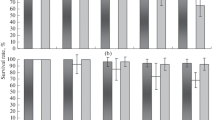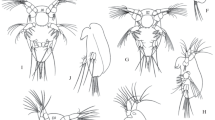Abstract
The pelagic copepod Acartia clausi Giesbrecht was bred 3 times from nauplius stages I and II to maturity at 5, 10, 15 and 20 °C and 4 different rations of autotrophic and heterotrophic food. The rate of development of copepods increased with increasing temperature and food level. At the highest food level the stage duration was almost constant through most stages, but development was not quite isochronal. Particularly at lower food concentrations stage duration became progressively longer with increasing stage of development. The relation between development time and temperature is described by Bělehrádek's functions at different food levels. These relations predict a generation time of about 50 days at spring bloom conditions and only slightly less during summer due to food limitation. Comparison with estimates in the field from the literature suggests hat food is often limiting during summer conditions.
Similar content being viewed by others
References
Bakker, C., M. L. M. Tackx & P. van Rijswijk, 1988. Plankton copepods Temora longicornis and Acartia tonsa and their food in the Oosterschelde estuary (S.W.-Netherlands). Hydrobiol. Bull. 22: 75–78.
Bradford, J. M., 1976. Partial revision of the Acartia subgenus Acartiura (Copepods: Calanoida: Acartiidae). N.Z. J. mar. Freshwat. Res. 10: 159–202.
Christou, E. D., G. C. Verriopoulos, 1993. Analysis of the biological cycle of Acartia clausi (Copepods) in a meso-oligotrophic coastal area of the eastern Mediterranean Sea using time-series analysis. Mar. Biol. 115: 643–651.
Corkett, C. J., 1984. Observations on development in copepods. Studies on Copepoda II. Crustaceana suppl. 7: 150–153.
Daan, R., 1987. Impact of egg production by Noctiluca miliaris on the summer development of copepod populations in the southern North Sea. Mar. Ecol. Prog. Ser. 37: 9–17.
Dann, R., S. R. Gonzalez & W. C. M. Klein Breteler, 1988. Cannibalism in omnivorous calanoid copepods. Mar. Ecol. Prog. Ser. 47: 45–54.
Daro, M. H. & B. van Gysegem, 1984. Ecological factors affecting weight, feeding and production of five dominant copepods in the Southern Bight of the North Sea. Rapp. Proc. Verh. Réun. Cons. Int. Explor. Mer 1983: 226–233.
Durbin, E. G. & A. G. Durbin, 1978. Length and weight relationships of Acartia clausi from Narragansett Bay, R. I. Limnol. Oceanogr. 23: 958–969.
Durbin, E. G., A. G. Durbin, T. J. Smayda & P. G. Verity, 1983. Food limitation of production by adult Acartia tonsa in Narragansett Bay, Rhode Island. Limnol. Oceanogr. 28: 1199–1213.
Durbin, E. G. & A. G. Durbin, 1992a. Seasonal changes in size frequency distribution and estimated age in the marine copepod Acartia hudsonica during a winter-spring diatom bloom in Narragansett Bay. Limnol. Oceanogr. 37: 379–392.
Durbin, E. G. & A. G. Durbin, 1992b. Effects of temperature and food abundance on grazing and short-term weight change in the marine copepod Acartia hudsonica. Limnol. Oceanogr. 37: 361–378.
Durbin, E. G., A. G. Durbin & R. G. Campbell, 1992. Body size and egg production in the marine copepod Acartia hudsonica during a winter-spring diatom bloom in Narragansett Bay. Limnol. Oceanogr. 37: 342–360.
Evans, F. 1981. An investigation into the relationship of sea temperature and food supply to the size of the planktonic copepod Temora longicornis Müller in the North Sea. Estuar. coast. Shelf Sci. 13: 145–158.
Fransz, H. G., S. R. Gonzalez & W. C. M. Klein Breteler, 1989. Fecundity as a factor controlling the seasonal population cycle in Temora longicornis (Copepod, Calanoida). In: J. S. Ryland & P. A. Tyler, Reproduction, genetics and distribution of marine organisms. Olsen & Olsen, Fredensborg: 83–90.
Fransz, H. G., S. R. Gonzalez, G. C. Cadée & F. C. Hansen, 1992. Long-term changes of Temora longicornis (Copepoda, Calanoida) abundance in a Dutch tidal inlet (Marsdiep) in relation to eutrophication. Neth. J. Sea Res. 30: 23–32.
Gaudy, R. 1976. Étude du plancton de la zone Nord de la rade de Villefranche-sur-Mer a la fin du printemps (17 May 71 au 16 Juin 7 1). III. Production secondaire de copépodes pélagiques. Vie Milieu 26: 77–106.
Guillard, R. R. L., 1975. Culture of phytoplankton for feeding marine invertebrates. In: Culture of marine invertebrate animals (Smith & Chanley, eds.). Plenum Press, NY & Lond.: 29–60.
Huntley, M. E. & M. D. G. Lopez, 1992. Temperature-dependent production of marine copepods: a global synthesis. Am. Nat. 140: 201–242.
Iwasaki, H., H. Katoh & T. Fujiyama, 1977. Cultivation of the marine copepod Acartia clausi Giesbrecht. I. Factors affecting the generation time and egg production. Bull. Plankton Soc. Jpn 24: 55–61.
Klein Breteler, W. C. M., 1980. Continuous breeding of marine pelagic copepods in the presence of heterotrophic dinoflagellates. Mar. Ecol. Prog. Ser. 2: 229–233.
Klein Breteler, W. C. M., H. G. Fransz & S. R. Gonzalez, 1982. Growth and development of four calanoid copepod species under experimental and natural conditions. Neth. J. Sea Res. 16: 195–207.
Klein Breteler, W. C. M. & S. R. Gonzalez, 1982. Influence of cultivation and food concentration on body length of calanoid copepods. Mar. Biol. 71: 157–161.
Klein Breteler, W. C. M. & S. R. Gonzalez, 1986. Culture and development of Temora longicornis (Copepoda, Calanoida) at different conditions of temperature and food. Syllogeus 58: 71–84.
Klein Breteler, W. C. M. & S. R. Gonzalez, 1988. Influence of temperature and food concentration on body size, weight and lipid content of two calanoid copepod species. Hydrobiologia 167/168: 201–210.
Klein Breteler, W. C. M., N. Schogt & S. R. Gonzalez, 1990. On the role of food quality in grazing and development of life stages, and genetic change of body size during cultivation of pelagic copepods. J. exp. mar. Biol. Ecol. 135: 177–189. Klein Breteler, W. C. M. & M. Laan, 1993. An apparatus for automatic counting and controlling density of pelagic food particles in cultures of marine organisms. Mar. Biol. 116: 169–174.
Klein Breteler, W. C. M., N. Schogt & J. van der Meer, 1994. The duration of copepod life stages estimated from stage frequency data. J. Plankton Res. (in press).
Krause, M. & J. Trahms, 1983. Zooplankton dynamics during FLEX '76. In: North Sea dynamics, Sündermann, J. & W. Lenz, eds. Springer-Verlag.
Landry, M. R., 1975. The relationship between temperature and the development of life stages of the marine copepod Acartia clausi Giesbr. Limnol. Oceanogr. 20: 854–858.
Landry, M. R., 1978. Population dynamics and production of a planktonic marine copepod, Acartia clausi, in a small temperate lagoon on San Juan Island, Washington. Int. Revue ges. Hydrobiol. 63: 77–119.
Landry, M. R., 1983. The development of marine calanoid copepods with comment on the isochronal rule. Limnol. Oceanogr. 28: 614–624.
Marshall, S. M., 1949. On the biology of the small copepods in Loch Striven. J. mar. biol. Ass. U.K. 28: 45–122.
Martens, P. 1981. On the Acartia species of the northern wadden sea of Sylt. Kieler Meeresforsch. 5: 153–163.
McLaren, I. A., 1963. Effects of temperature on growth of zooplankton, and the adaptive value of vertical migration. J. Fish. Res. Bd Can. 20: 685–727.
McLaren, I. A., 1965. Some relationships between temperature and egg size, body size, development rate, and fecundity, of the copepod Pseudocalanus. Limnol. Oceanogr. 10: 528–538.
McLaren, I. A., 1966. Predicting development rate of copepod eggs. Biol. Bull. Mar. Biol. Lab., Woods Hole 131: 457–469.
McLaren, I. A., 1978. Generation lengths of some temperate marine copepods: estimation, prediction, and implications. J. Fish. Res. Bd Can. 35: 1330–1342.
McLaren, I. A., J.-M. Sévigny & C. J. Corkett, 1987. Temperature-dependent development in Pseudocalanus species. Can. J. Zool. 67: 559–564.
Miller, C. B., M. E. Huntley & E. R. Brooks, 1984. Post-collection molting rates of planktonic, marine copepods: measurement, applications, problems. Limnol. Oceanogr. 29: 1274–1289.
Peterson, W. T., 1985. Abundance, age structure and in situ egg production rates of the copepod Temora longicornis in Long Island Sound, New York. Bull. mar. Sci. 37: 726–738.
Peterson, W. T. & D. C. Bellantoni, 1987. Relationships between water-column stratification, phytoplankton cell size and copepod fecundity. S. Afr. J. mar. Sci. 5: 411–421.
Ueda, H., 1978. Analysis of the generations of inlet copepods, with special reference to Acartia clausi in Maizuru Bay, middle Japan. Bull. Plankton Soc. Jpn 25: 55–66.
Ueda, H., 1986. Taxonomic reexamination and geographic distribution of copepods known as Acartia clausi in Japanese coastal and inlet waters. J. Oceanogr. Soc. Jpn. 42: 134–138.
Uye, S-I., 1980. Development of neritic copepods Acartia clausi and A. steueri. II. Isochronal larval development at various temperatures. Bull. Plankton Soc. Jpn 27: 11–18.
Uye, S.-I., 1982. Population dynamics and production of Acartia clausi Giesbrecht (Copepoda: Calanoida) in inlet waters. J. exp. mar. Biol. Ecol. 57: 55–83.
Author information
Authors and Affiliations
Rights and permissions
About this article
Cite this article
Klein Breteler, W.C.M., Schogt, N. Development of Acartia clausi (Copepoda, Calanoida) cultured at different conditions of temperature and food. Hydrobiologia 292, 469–479 (1994). https://doi.org/10.1007/BF00229974
Issue Date:
DOI: https://doi.org/10.1007/BF00229974




